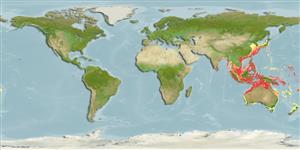Environment: milieu / climate zone / profondeur / distribution range
Écologie
marin démersal. Tropical
Eastern Indian Ocean: Indonesia and northwestern Australia (Ref. 5978). Also known from Papua New Guinea (Ref. 6192).
Taille / Poids / Âge
Maturité: Lm ? range ? - ? cm
Max length : 16.5 cm TL mâle / non sexé; (Ref. 3131)
Épines dorsales (Total) : 4 - 5; Rayons mous dorsaux (Total) : 13 - 14; Rayons mous anaux: 12 - 15. A short black cirrus on eye. Respiratory valve inside lower jaw with a thread-like, pale appendage. Body without distinctive colour marks. Upper edge of opercle descending backward. Both nasal valves long and tubular. First dorsal fin with 4 (rarely 3) spines. Two basipterygial processes (Ref 42788)..
Body shape (shape guide): elongated.
Life cycle and mating behavior
Maturité | Reproduction | Frai | Œufs | Fécondité | Larves
Sainsbury, K.J., P.J. Kailola and G.G. Leyland, 1985. Continental shelf fishes of the northern and north-western Australia. An illustrated guide. CSIRO Division of Fisheries Research; Clouston & Hall and Peter Pownall Fisheries Information Service, Canberra, Australia. 375 p. (Ref. 3131)
Statut dans la liste rouge de l'IUCN (Ref. 130435: Version 2025-1)
Menace pour l'homme
Harmless
Utilisations par l'homme
Pêcheries: bycatch
Outils
Articles particuliers
Télécharger en XML
Sources Internet
Estimates based on models
Preferred temperature (Réf.
123201): 19.1 - 28.2, mean 25.9 °C (based on 791 cells).
Phylogenetic diversity index (Réf.
82804): PD
50 = 0.5000 [Uniqueness, from 0.5 = low to 2.0 = high].
Bayesian length-weight: a=0.00794 (0.00322 - 0.01959), b=3.09 (2.89 - 3.29), in cm total length, based on LWR estimates for this Genus-body shape (Ref.
93245).
Niveau trophique (Réf.
69278): 3.9 ±0.6 se; based on size and trophs of closest relatives
Résilience (Réf.
120179): Haut, temps minimum de doublement de population inférieur à 15 mois (Preliminary K or Fecundity.).
Fishing Vulnerability (Ref.
59153): Low vulnerability (10 of 100).
🛈
